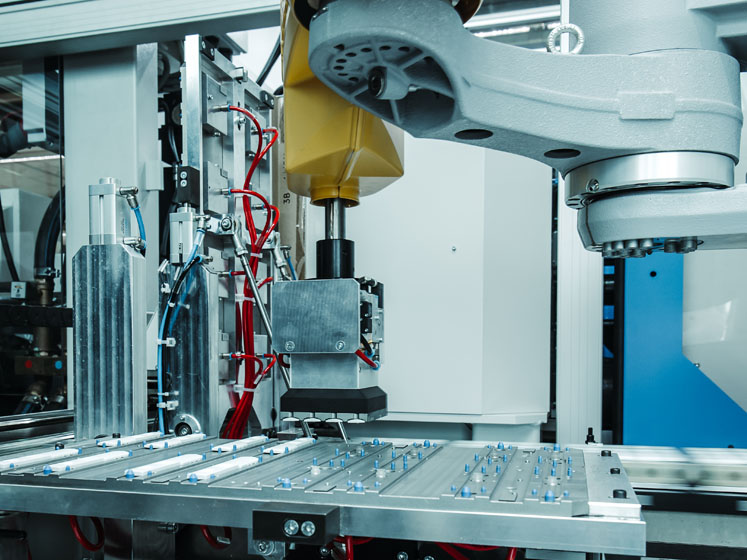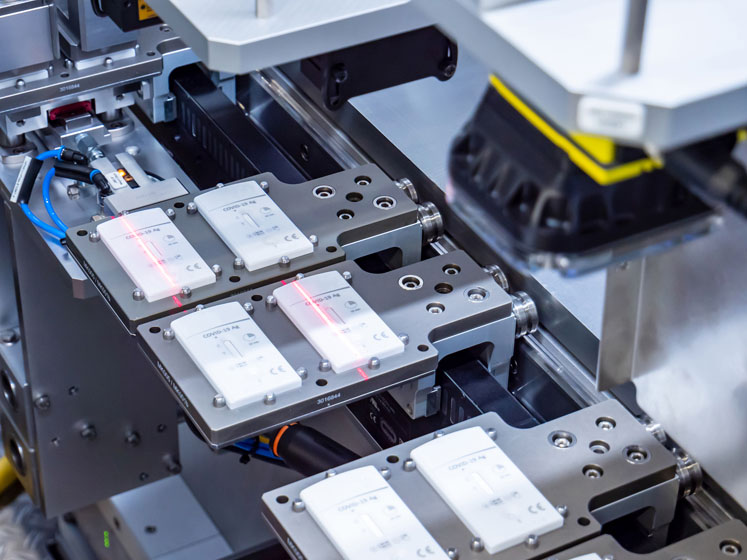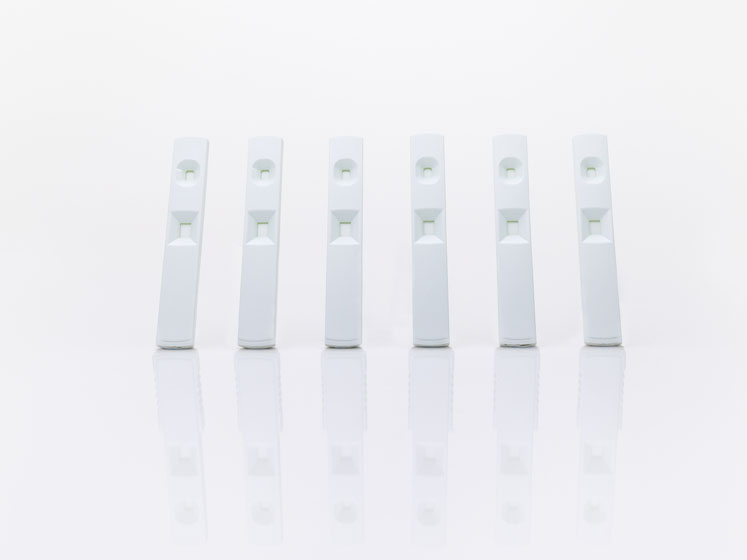Volatile supply chains are once again increasing the importance of local production, resulting in the recent collaboration between automation expert, MA micro automation, and Sanner, a leading supplier of primary packaging as well as medtech and diagnostics applications.
Thanks to a fully automated production process, rapid tests and other medtech products can be manufactured cost-effectively in Europe.
Sanner and MA micro automation are almost neighbours: their respective production facilities in Bensheim and St Leon-Roth in Germany are only 60 km apart. The assembly cycle time of the new CERES POC system for small batch sizes is even more impressive: it only requires 750 ms per part.
This is particularly relevant for the highly diverse German and European laboratory landscape. Innovative small and medium-sized companies develop test strips including chemical equipment to detect a wide variety of substances. COVID tests are just one example; they also include diabetes, early heart attack detection, pregnancy or drug tests.
Although lateral flow tests (LFTs) are easy to use, their development and production is challenging. Manufacturers must take a wide variety of biological, chemical and physical factors into account to provide high-quality test instruments that deliver reliable results — especially when it comes to early detection.

Sanner helps medtech and diagnostics companies to find optimal solutions, such as point-of-care (PoC) tests or in vitro diagnostics. MA micro automation, in turn, designs and supplies complex automation solutions with a focus on medtech applications. Both companies have now combined their expertise.
Local companies for local production
Owing to insufficient quantities, the in-house production of test cassettes is not profitable for many laboratories. Instead, they currently still purchase standardised products from Asia and assemble them according to their needs.
If the total volumes of many small laboratories were combined with a highly efficient assembly line, LFTs and other medtech products could also be manufactured locally — with easier-to-handle logistics, better quality control and individual procurement.
The CERES POC system from MA micro automation provides a possible basis. It can equip test cassettes with up to three test strips and assemble them in as little as 750 ms per cassette.
This enables Sanner to offer both customised and standard cassettes, which can be used flexibly and cover the needs of many customers. A precise fit is essential to achieve an effective lateral flow (that is, uniform spreading on the sample liquid along the test strip).
Focus on the plastic housing
LFTs require a complex interplay of many individual components: from the selection of the chemical reagents to the quality and exact cutting of the test strip material, as well as the alignment and precise overlapping of the individual pads (which are attached via pressure points in the plastic housing).
When designing rapid tests, the focus is on ease of use, so that both laypersons and specialists receive a reliable test result in the shortest possible time. Sanner leverages its expertise in precision injection moulding and tooling to develop the housing and functional parts in line with specific requirements, thus delivering precise measurement results.

Thanks to their simple application and short response times, LFTs are suitable for non-professionals to use. However, their reliability depends on precise construction.
Several factors are important in the manufacturing process: material properties, chemical composition, sample construction and the plastic housing. The functionality of the housing is often underestimated.
It not only protects the test strip from external influences such as moisture and stabilises its positioning, various design features also enable an optimal flow rate at key points.
Thanks to precisely matched and conceptualised openings, recesses and fixation points, the structure of the housing provides a microfluidic channel through which the sample fluid passes to the result display. The design of the plastic housing is therefore one of the most important project phases in the product development of an LFT.
A demanding assembly process
The assembly process is just as complex. Preproduced and available as bulk material, the cassettes are separated, aligned and fed to the assembly line. Up to three cutting modules are docked to the line and prepare the material for the test strips.
At 300 mm in length, the cards have a width of around 60, 80 or 95 mm. Once visual inspection systems have checked whether the reaction agent or test chemical has been applied everywhere, the cutting modules cut the cards into individual test strips, automatically ejecting any faulty parts in the raw material.
The test strips are then exactly placed on the bottom parts of the cassette and inspected for correct positioning using 3D scanning technology. This step is followed by the assembly and inspection of the top parts.
Depending on the manufacturing method, their dimensional accuracy is usually sufficient for manual assembly … but not for the trouble-free operation of a high-performance machine. Sanner solves this problem by producing all cassette components with the new CERES POC system.
Optical individualisation and integrated desiccants
The optical individualisation of the tests is at the heart of MA micro automation’s concept: LFTs and similar products are usually marked via pad printing. However, should a product change, this technology requires a time-consuming conversion to a new template, thus causing downtimes.
In contrast, the CERES POC uses two marking lasers. These are able to apply comprehensive markings in a short cycle time and can simply switch from one program to another when a variant is changed.
In this way, every laboratory can achieve its own individual marking, including logos. When changing customer orders, only the card material for the test strips is exchanged and the laser program is activated.

A defined press force unites the top and bottom parts to form a finished cassette, while sensory testing monitors whether everything has been properly assembled. A final camera checks the labels once more before the finished tests leave the machine via a conveyor belt towards the packaging line.
Here, desiccants can be included in addition to the cassettes. These are crucial for the safety and functionality of the LFTs.
As a European pioneer in the integration of desiccants in the packaging of moisture-sensitive products and devices, Sanner can undertake the final packaging of the tests in aluminium pouches, including the addition of a Sanner desiccant sachet.
A future-proof co-operation
The co-operation between Sanner and MA micro automation adds many small production volumes together; the flexible CERES POC makes local test manufacturing attractive and efficient.
MA micro automation possesses the necessary know-how, so that image processing, IT and the mechanical design of the automation complement each other.
Sanner, in turn, is the world market leader in desiccant packaging, as well as a sought-after provider of individual development services and contract manufacturing in the medtech, diagnostics and pharmaceutical sectors.
Thanks to the co-operation with MA micro automation, the company will be able to further expand its position in Europe.
